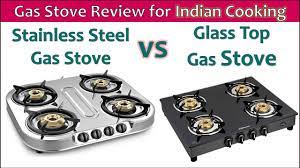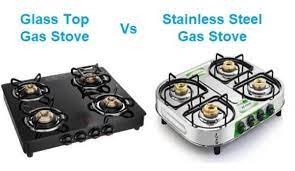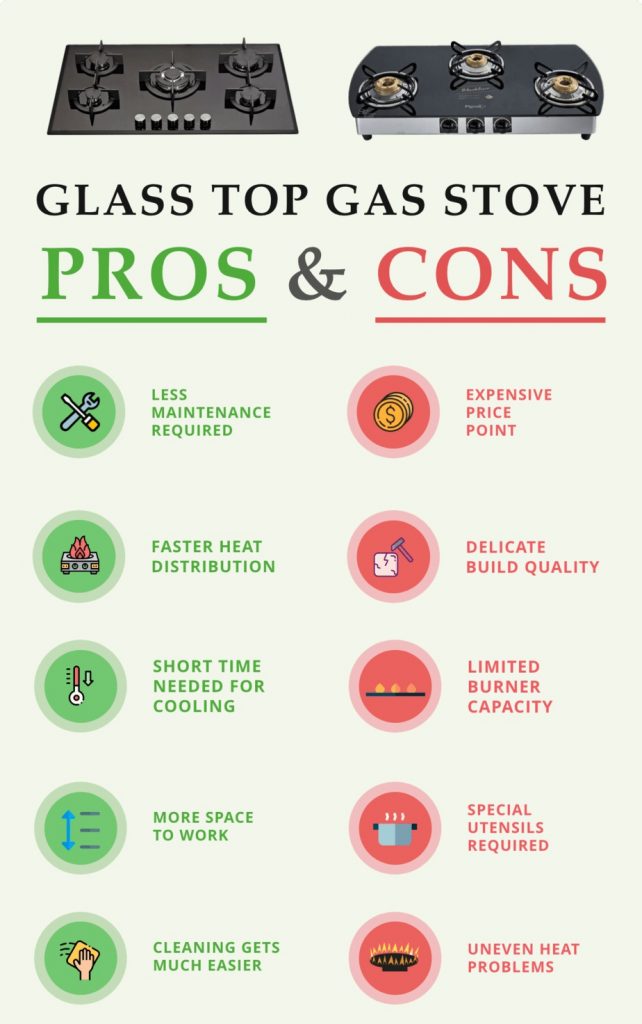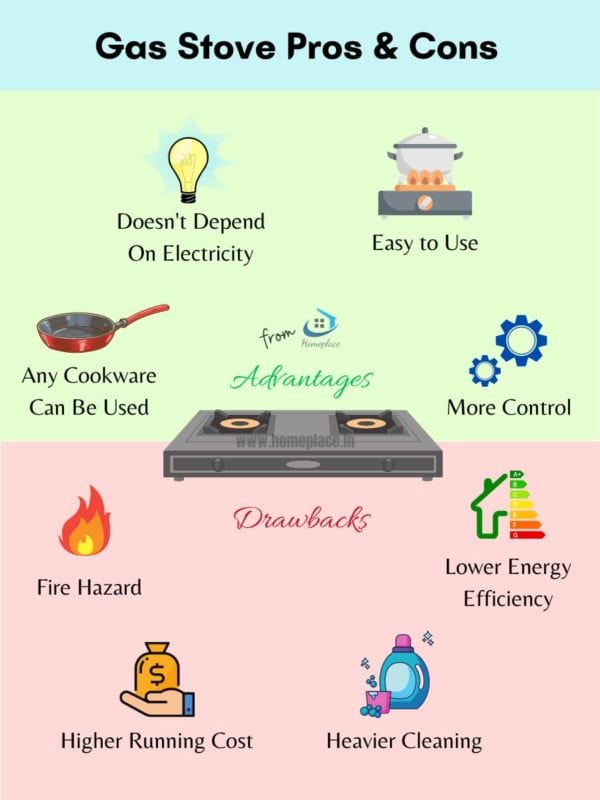Disadvantages and Advantages of Glass Top Gas Stove and Normal Steel Gas Stove
Outline
I. Introduction
- A brief overview of the topic
- Importance of choosing the right stove
II. Advantages of Glass Top Gas Stove
- Elegant and modern appearance
- Easy to clean and maintain
- Even heat distribution
III. Disadvantages of Glass Top Gas Stove
- Prone to scratches and cracks
- Limited weight capacity
- Cost considerations
IV. Advantages of Normal Steel Gas Stove
- Durability and sturdiness
- Budget-friendly option
- Wide range of designs and features
V. Disadvantages of Normal Steel Gas Stove
- Susceptible to rust and corrosion
- Cleaning challenges
- Uneven heat distribution
VI. Comparing Energy Efficiency
- Efficiency of both types of stoves
- Impact on utility bills
VII. Safety Considerations
- Safety features of glass top gas stoves
- Safety concerns with steel gas stoves
VIII. Maintenance and Cleaning Tips
- Tips for maintaining glass top gas stoves
- Cleaning hacks for normal steel gas stoves
IX. Environmental Impact
- Assessing the eco-friendliness of both stoves
- Sustainable choices for eco-conscious consumers
X. Consumer Reviews and Ratings
- Analyzing user experiences with both stove types
- Common complaints and praises
XI. Customization and Aesthetics
- Personalization options for glass top stoves
- Design versatility of steel gas stoves
XII. Consideration of Kitchen Space
- Space requirements for different stove models
- Choosing the right fit for your kitchen
XIII. Longevity and Lifespan
- Lifespan expectations for glass top gas stoves
- Comparing the longevity of steel gas stoves
XIV. Warranty and After-Sales Service
- Warranty offerings from manufacturers
- Importance of reliable after-sales service
XV. Conclusion
- Summarizing key points
- Making an informed choice based on preferences and needs
I. Introduction
In a world where kitchen aesthetics and efficiency go hand in hand, the selection of a gas stove is no longer a mundane task. The type of stove you choose can significantly impact your cooking experience and the overall vibe of your kitchen. In this article, we’ll dive into the world of glass top gas stoves and normal steel gas stoves, examining the pros and cons of each to guide you in making the right choice.II. Advantages of Glass Top Gas Stove
Elegant and Modern Appearance
One of the primary draws of glass top gas stoves is their sleek and contemporary design. The glass surface adds a touch of elegance to your kitchen, instantly elevating its aesthetic appeal. If you’re aiming for a modern and stylish kitchen, a glass top gas stove might be the perfect addition.Easy to Clean and Maintain
Cleaning up after cooking can be a hassle, but glass top gas stoves simplify this task. The smooth glass surface is easy to wipe clean, and spills or splatters don’t stick stubbornly. This advantage is a game-changer for those who appreciate a tidy kitchen without investing too much time in maintenance.Even Heat Distribution
Glass top gas stoves provide uniform heat distribution across the entire surface. This ensures that your pots and pans receive consistent heat, leading to better-cooked meals. The even heat distribution is a boon for precision cooking, making glass top stoves a favorite among culinary enthusiasts.III. Disadvantages of Glass Top Gas Stove
Prone to Scratches and Cracks
While the glass surface exudes sophistication, it’s also susceptible to scratches and cracks. Careless handling of utensils or accidentally dropping heavy objects can mar the pristine surface. Homeowners with a bustling kitchen may need to exercise caution to maintain the stove’s appearance.Limited Weight Capacity
Glass top gas stoves have a restricted weight capacity compared to their steel counterparts. This limitation can be a drawback for those who frequently use large or heavy cookware. Before investing in a glass top stove, it’s crucial to consider the weight of your commonly used pots and pans.Cost Considerations
The initial cost of a glass top gas stove tends to be higher than that of a normal steel gas stove. While the sleek design and modern appeal justify the expense for many, budget-conscious consumers might find this aspect a drawback. It’s essential to weigh the upfront cost against the long-term benefits.IV. Advantages of Normal Steel Gas Stove
Durability and Sturdiness
Normal steel gas stoves are renowned for their durability and sturdiness. The robust construction can withstand the rigors of daily cooking, making steel stoves an ideal choice for households with high cooking frequencies. If you prioritize longevity, a steel gas stove might be the right fit for you.Budget-Friendly Option
One of the standout advantages of normal steel gas stoves is their affordability. These stoves offer excellent functionality at a lower price point, making them accessible to a wide range of consumers. If you’re working within a budget but still want a reliable stove, steel might be the way to go.Wide Range of Designs and Features
Steel gas stoves come in various designs and offer a plethora of features. From traditional designs to modern innovations, steel stoves cater to diverse preferences. Whether you’re a minimalist or someone who loves advanced cooking technology, you’ll likely find a steel stove that suits your needs.V. Disadvantages of Normal Steel Gas Stove
Susceptible to Rust and Corrosion
Despite their durability, normal steel gas stoves are prone to rust and corrosion over time. Exposure to moisture, especially in humid environments, can expedite this process. Regular maintenance and protective measures are necessary to prevent rust and ensure the stove’s longevity.Cleaning Challenges
Cleaning a steel gas stove can be more labor-intensive compared to its glass counterpart. Spills and stains may stick to the surfaces, requiring extra effort to scrub away. For those who prioritize easy cleaning, this aspect might be a drawback.Uneven Heat Distribution
Unlike glass top gas stoves, steel stoves may exhibit uneven heat distribution. Certain spots on the burner might get hotter than others, leading to unevenly cooked food. Cooks who rely on precise temperature control may find this aspect challenging.VI. Comparing Energy Efficiency
As we delve into the world of gas stoves, energy efficiency becomes a critical factor to consider. Both glass top and normal steel gas stoves operate on similar principles, utilizing gas as a fuel source. However, nuances in design and materials can affect their overall efficiency.XV. Conclusion
In the realm of kitchen appliances, the choice between a glass top gas stove and a normal steel gas stove boils down to personal preferences and practical considerations. Each type comes with its own set of advantages and disadvantages, catering to different needs and lifestyles. Whether you prioritize modern aesthetics, durability, or budget-friendly options, understanding the nuances of each stove type empowers you to make a decision that aligns with your culinary vision.FAQs
- Q: Can I use cast iron cookware on a glass top gas stove?
- A: While it’s possible, it’s advisable to exercise caution to prevent scratches. Consider using cast iron with smooth bottoms.
- Q: Are glass top gas stoves more energy-efficient than steel stoves?
- A: Both types operate on similar principles, but the design and materials can impact efficiency. Read user reviews and product specifications for accurate information.
- Q: How can I prevent rust on a steel gas stove?
- A: Regularly wipe down the surfaces, keep the area dry, and apply a protective coating if recommended by the manufacturer.
- Q: What’s the average lifespan of a glass top gas stove?
- A: With proper care, a glass top gas stove can last for many years. Check the manufacturer’s guidelines for specific information.
- Q: Can I install a steel gas stove in an outdoor kitchen?
- A: It’s possible, but ensure the stove is designed for outdoor use and can withstand exposure to the elements.
- Product on sale
 Ultra Optiflame 70%+ Efficient SS Gas Stove 2 Forged Brass Burners,10-Year Warranty on Burners, Manual Ignition, ISI Certified.Unique Pansupport&Burner Locking For Easy Cleaning,Spacious Design.Original price was: ₹7,490.00.₹7,190.00Current price is: ₹7,190.00.
Ultra Optiflame 70%+ Efficient SS Gas Stove 2 Forged Brass Burners,10-Year Warranty on Burners, Manual Ignition, ISI Certified.Unique Pansupport&Burner Locking For Easy Cleaning,Spacious Design.Original price was: ₹7,490.00.₹7,190.00Current price is: ₹7,190.00. - Product on sale
 Ultra Optiflame 70%+ Efficient Glass Top Gas Stove 2 Forged Brass Burners,10-Years Warranty onBurners,Manual Ignition, ISICertified.Unique Pansupport&Burner Locking For Easy Cleaning,Spacious Design.Original price was: ₹9,990.00.₹9,190.00Current price is: ₹9,190.00.
Ultra Optiflame 70%+ Efficient Glass Top Gas Stove 2 Forged Brass Burners,10-Years Warranty onBurners,Manual Ignition, ISICertified.Unique Pansupport&Burner Locking For Easy Cleaning,Spacious Design.Original price was: ₹9,990.00.₹9,190.00Current price is: ₹9,190.00. - Product on sale
 Bosch PIE651BB5I 1800W Glass Ceramic Induction Hob With 4 Cooking Zone, BlackOriginal price was: ₹79,990.00.₹58,799.00Current price is: ₹58,799.00.
Bosch PIE651BB5I 1800W Glass Ceramic Induction Hob With 4 Cooking Zone, BlackOriginal price was: ₹79,990.00.₹58,799.00Current price is: ₹58,799.00. - Product on sale
 Bosch Built in Gas Hob Black Tempered glass Glass 5 Burner Auto Ignition 90 cm Full Brass 3D Ring Burners with Matt Black Heat Shields & Cast Iron pan supports (PNV9B6G20I)Original price was: ₹79,990.00.₹55,899.00Current price is: ₹55,899.00.
Bosch Built in Gas Hob Black Tempered glass Glass 5 Burner Auto Ignition 90 cm Full Brass 3D Ring Burners with Matt Black Heat Shields & Cast Iron pan supports (PNV9B6G20I)Original price was: ₹79,990.00.₹55,899.00Current price is: ₹55,899.00. - Product on sale
 Bosch Built in Gas Hob Black Tempered glass Glass 4 Burner Auto Ignition 90 cm Full Brass 3D Ring Burners with Matt Black Heat Shields & Cast Iron pan supports (PNF9B6G20I)Original price was: ₹74,990.00.₹52,899.00Current price is: ₹52,899.00.
Bosch Built in Gas Hob Black Tempered glass Glass 4 Burner Auto Ignition 90 cm Full Brass 3D Ring Burners with Matt Black Heat Shields & Cast Iron pan supports (PNF9B6G20I)Original price was: ₹74,990.00.₹52,899.00Current price is: ₹52,899.00. - Product on sale
 Bosch Built in Gas Hob Black Tempered glass Glass 5 Burner Auto Ignition 90 cm True Brass 2D Ring Burners with Matt Black Heat Shields & Cast Iron pan supports (PNV9B6F20I)Original price was: ₹69,990.00.₹46,899.00Current price is: ₹46,899.00.
Bosch Built in Gas Hob Black Tempered glass Glass 5 Burner Auto Ignition 90 cm True Brass 2D Ring Burners with Matt Black Heat Shields & Cast Iron pan supports (PNV9B6F20I)Original price was: ₹69,990.00.₹46,899.00Current price is: ₹46,899.00. - Product on sale
 Bosch Built in Gas Hob Black Tempered glass Glass 4 Burner Auto Ignition 90 cm True Brass 2D Ring Burners with Matt Black Heat Shields & Cast Iron pan supports (PNF9B6F20I)Original price was: ₹64,990.00.₹47,999.00Current price is: ₹47,999.00.
Bosch Built in Gas Hob Black Tempered glass Glass 4 Burner Auto Ignition 90 cm True Brass 2D Ring Burners with Matt Black Heat Shields & Cast Iron pan supports (PNF9B6F20I)Original price was: ₹64,990.00.₹47,999.00Current price is: ₹47,999.00. - Product on sale
 Bosch 90 cm Built in Hob with 5 Burners, Swords Knob (Black, PNV9B6F10I)Original price was: ₹61,990.00.₹41,999.00Current price is: ₹41,999.00.
Bosch 90 cm Built in Hob with 5 Burners, Swords Knob (Black, PNV9B6F10I)Original price was: ₹61,990.00.₹41,999.00Current price is: ₹41,999.00. - Product on sale
 Bosch Built in Gas Hob Black Tempered glass Glass 3 Burner Auto Ignition 75 cm Full Brass 3D Ring Burners with Matt Black Heat Shields & Cast Iron pan supports (PND7B6G20I)Original price was: ₹59,990.00.₹43,999.00Current price is: ₹43,999.00.
Bosch Built in Gas Hob Black Tempered glass Glass 3 Burner Auto Ignition 75 cm Full Brass 3D Ring Burners with Matt Black Heat Shields & Cast Iron pan supports (PND7B6G20I)Original price was: ₹59,990.00.₹43,999.00Current price is: ₹43,999.00.


























